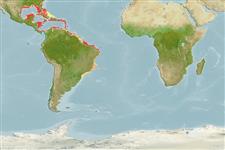>
Eupercaria/misc (Various families in series Eupercaria) >
Scaridae (Parrotfishes) > Sparisomatinae
Etymology: Cryptotomus: Greek, kryptos = hidden + Greek, tomos, = section, cut (Ref. 45335).
More on author: Cope.
Environment: milieu / climate zone / depth range / distribution range
Écologie
marin récifal; profondeur ? - 60 m (Ref. 13628). Tropical; 32°N - 33°S
Western Atlantic: Bermuda, southern Florida (USA), and Bahamas to Brazil (Ref. 7251). Possibly in Ascension I. (Ref. 98447).
Taille / Poids / Âge
Maturity: Lm ? range ? - ? cm
Max length : 13.0 cm TL mâle / non sexé; (Ref. 7251); common length : 10.0 cm TL mâle / non sexé; (Ref. 5217)
Épines dorsales (Total) : 9; Rayons mous dorsaux (Total) : 10; Épines anales: 2; Rayons mous anaux: 9. Jaw teeth fused only at bases. Anterior nostril without membranous flap (Ref. 26938). Male color, olivaceous on the back with small pink dots; a salmon stripe along the side with a row of green dots; body below stripe light green with some salmon markings on scales (Ref. 13442).
Inhabits seagrass beds and weedy areas with sand (Ref. 9710). Feeds on seagrasses (Ref. 9710). Buries in the sand to sleep in a mucus tube (Ref. 9710). Protogynous hermaphrodite (Ref. 55367).
Life cycle and mating behavior
Maturité | Reproduction | Frai | Œufs | Fécondité | Larves
Forms leks during breeding (Ref. 55367). A monandric species (Ref. 55367). Length at sex change = 5.75 cm TL (Ref. 55367).
Robins, C.R. and G.C. Ray, 1986. A field guide to Atlantic coast fishes of North America. Houghton Mifflin Company, Boston, U.S.A. 354 p. (Ref. 7251)
Statut dans la liste rouge de l'IUCN (Ref. 130435: Version 2024-1)
Menace pour l'homme
Harmless
Utilisations par l'homme
Pêcheries: commercial; Aquarium: Commercial
Outils
Articles particuliers
Télécharger en XML
Sources Internet
Estimates based on models
Preferred temperature (Ref.
123201): 24.4 - 28, mean 26.9 °C (based on 316 cells).
Phylogenetic diversity index (Ref.
82804): PD
50 = 1.0000 [Uniqueness, from 0.5 = low to 2.0 = high].
Bayesian length-weight: a=0.01096 (0.00689 - 0.01745), b=3.16 (3.02 - 3.30), in cm total length, based on LWR estimates for this species & (Sub)family-body (Ref.
93245).
Niveau trophique (Ref.
69278): 2.0 ±0.00 se; based on food items.
Résilience (Ref.
120179): Haut, temps minimum de doublement de population inférieur à 15 mois (Preliminary K or Fecundity.).
Fishing Vulnerability (Ref.
59153): Low vulnerability (10 of 100).
Nutrients (Ref.
124155): Calcium = 117 [65, 245] mg/100g; Iron = 1.11 [0.58, 1.89] mg/100g; Protein = 18.3 [16.3, 20.1] %; Omega3 = 0.129 [0.071, 0.230] g/100g; Selenium = 39.1 [20.2, 77.6] μg/100g; VitaminA = 54 [16, 189] μg/100g; Zinc = 2.57 [1.69, 4.08] mg/100g (wet weight);
